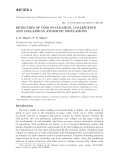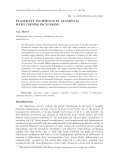Extraction of required information from atomic configurations is crucial for efficient use of molecular dynamics (MD) simulations, and automating this process allows the collection of statistical data to develop and validate physical models and data-driven approaches. Here we update the previously developed pore searching algorithm to automatically detect the events of void nucleation, collapse and coalescence by comparing pairs of atomic configurations. We calculate an intersection matrix, which shows common regions between voids of current and previous time frames, and analysis of this intersection matrix gives a numerical criterion for determination of the considered events. The updated algorithm is verified in the case of small MD system and further used to analyze a large MD system with many hundreds of voids. The predominance of void collapse is confirmed in the case of uniform triaxial tension of solid aluminum, while void coalescence instead of collapse is detected in the case of a more complex loading with axial compression and lateral tension. This dependence of the predominant mechanism on the loading path correlates with previous finite element analysis in the literature. Another interesting finding is a continuing nucleation and collapse of voids far beyond the fracture beginning at a level of negative pressure much lower than the spall strength, which can be attributed to a developed defect structure of material produced by plastic growth of voids.
The dislocation activity controls the plastic deformation in the most of metallic materials. Mechanical loading with high strain rates or with high strain gradients can lead to either homogeneous nucleation of the dislocation or emission of dislocations from various heterogeneities, such as nanopores and phase precipitates. The dislocation nucleation and emission trigger plasticity, which relaxes the shear component of stresses. In this work, we study the threshold of dislocation emission from nanosized copper inclusions in an aluminum single crystal in comparison with the homogeneous nucleation of dislocations in pure metal. We consider different shapes of inclusions (spherical, cylindrical and cubic) and rather arbitrary axisymmetric deformations by means of molecular dynamics (MD) simulations. For most deformation paths, the copper inclusions substantially reduce the threshold of plasticity incipience, while the inclusions have no effect for some deformation paths with either axial or transverse extension. Depending on the deformation path, the shape of inclusion can either influence the emission threshold or not. Thus, there is a complex dependence of the threshold of plasticity incipience on the deformation path, the presence and the form of copper inclusions. This dependence is approximated by means of an artificial neural network (ANN) trained on the results of MD simulations. The trained ANN can be further applied as a constitutive equation at the level of continuum mechanics.

